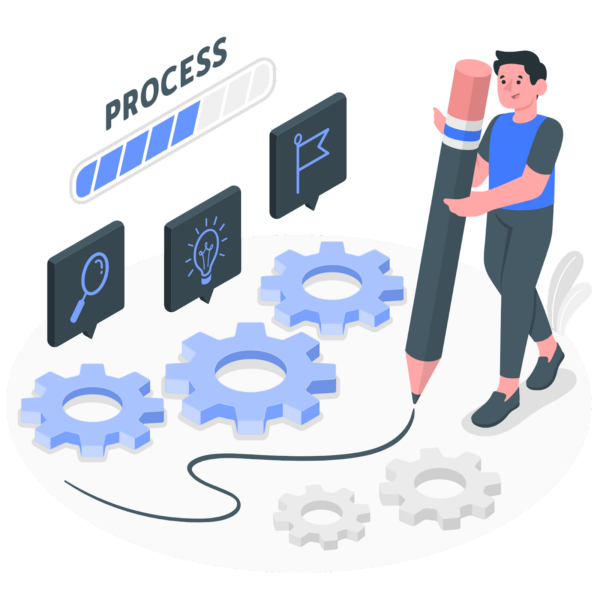Table of Contents
What is a Workflow?
A workflow is defined as the systematic organization of resources to build processes that transform materials, provide services, or process information. It is essentially a sequence of operations conducted by a person, a group of people, or one or more simple or complex mechanisms.
Workflows are fundamental to every industry. They are the building blocks of business operations, integrated with other organizational structures such as information technology, teams, projects, and hierarchies. By optimizing workflows, businesses can enhance efficiency, productivity, and overall performance.
This article will define a workflow process, explain its key components and various types, and demonstrate how using online whiteboards to create and monitor workflows can improve team efficiency.

Components of a Workflow
- Tasks: The individual steps or actions that need to be completed within the workflow. Tasks can vary in complexity and can be manual or automated.
- Actors: The individuals, teams, or systems responsible for executing the tasks. Clear assignment of responsibilities ensures accountability and smooth workflow progression.
- Sequence: The specific order in which tasks are performed. Sequencing is crucial to maintain the logical flow of the process and achieve desired outcomes.
- Rules: The guidelines and conditions that dictate the flow from one task to another. Rules ensure that tasks are executed correctly and efficiently.
- Tools: Software and resources used to manage, visualize, and automate tasks within the workflow. Common tools include workflow management software, online whiteboards, and process mapping tools.
Types of Workflows
1. Linear Workflows
Tasks are completed in a predefined, step-by-step sequence. Linear workflows are straightforward and ideal for processes with clear, sequential steps.
2. Parallel Workflows
Multiple tasks are carried out simultaneously, often by different team members or systems. Parallel workflows are efficient for complex processes that can be broken down into concurrent activities.
3. Looping Workflows
Tasks are carried out repeatedly until a specified condition is satisfied. Looping workflows are useful for iterative processes, such as quality control or continuous improvement cycles.
4. Automated Workflows
Tasks are automated using software tools, reducing the need for manual intervention. Automation enhances efficiency and accuracy by minimizing human error.

Benefits of Using Online Whiteboards for Workflows
- Visualization: Online whiteboards provide a clear and interactive visual representation of workflows, making it easier to understand and manage processes. Visual aids like flow charts and process maps can enhance comprehension.
- Collaboration: Teams can collaborate in real-time, adding comments, updates, and feedback directly on the workflow. This enhances communication and coordination among team members.
- Efficiency: Monitoring workflows on online whiteboards can help identify bottlenecks, streamline processes, and improve overall efficiency. Real-time updates ensure that everyone stays informed.
- Flexibility: Online whiteboards allow for easy adjustments to workflows as projects evolve and requirements change. Adaptability is essential in dynamic business environments.
Workflow Examples
Workflows are essential for organizing and optimizing business processes across various industries. By understanding and implementing effective workflows, businesses can enhance efficiency, ensure compliance, and improve overall performance. Whether it’s managing sales orders, purchase orders, onboarding new team members, or processing e-commerce transactions, streamlined workflows are key to operational success.
Workflows are integral to the efficiency and success of any business. Here, we’ll look at some common examples of workflows across various industries.
1. Sales Order Workflow
A sales order workflow is a crucial component of every business. It typically involves the following stages:
- Order Creation: A salesperson creates a sales order based on customer requirements.
- Invoice Billing: The client is billed with an invoice detailing the order.
- Invoice Payment: The client pays the invoice through the preferred payment method.
- Order Fulfillment: The fulfillment department processes the order and delivers the product to the client.
This structured workflow ensures that sales orders are managed efficiently, resulting in timely deliveries and satisfied customers.
2. Purchase Order Workflow
Purchase orders are essential for businesses to manage their overall spend and maintain transparency with suppliers. A typical purchase order workflow includes:
- PO Creation: The procurement team creates a purchase order (PO).
- Approval: A manager reviews and approves the PO.
- Submission: The approved PO is sent to the supplier.
- Receipt of Goods/Services: The supplier delivers the goods or services as per the PO.
- Invoice Receipt and Authorization: An invoice is received from the supplier and authorized for payment.
- Payment: The supplier is paid according to the agreed terms.
This workflow ensures that all purchasing activities are streamlined, documented, and executed efficiently.
3. Team Member Onboarding Workflow
Onboarding new employees is a critical process in various industries such as banking, insurance, and technology. A typical onboarding workflow includes:
- Application Submission: The candidate submits an application for the job.
- Verification: Conduct client identification verification and background checks.
- Documentation: Provide statement disclosure and gather necessary documentation.
- Approvals: Obtain necessary approvals, such as credit or employment authorizations.
- Contract Signing: Finalize the hiring process with contract signing.
- Orientation: Conduct onboarding orientation and training sessions.
- Record Keeping: Document and save all transaction records for audit purposes.
A well-structured onboarding workflow ensures a smooth transition for new hires and compliance with regulatory requirements.
4. E-Commerce Order Workflow
Order processing is a standard workflow in the e-commerce industry. Here’s how it typically works:
- Order Submission: A consumer places an order on the e-commerce platform.
- Payment Processing: The consumer enters payment information and completes the transaction.
- Order Confirmation: The platform confirms the order and processes the payment.
- Picking and Packing: The item(s) are picked from the warehouse, packaged into a parcel, and prepared for shipment.
- Dispatch: The parcel is dispatched to the consumer with tracking information.
This workflow ensures that e-commerce operations run smoothly, providing a seamless shopping experience for customers.

The Advantages of Using Workflows
Workflows offer an excellent opportunity to break out of inefficient teamwork patterns and adopt a new strategy for collaboration. Here are some key reasons why implementing workflows is essential and advantageous:
1. Increased Productivity
By creating a workflow diagram, you provide a clear blueprint for your teams to follow when solving problems and completing tasks. Teams are more efficient when they share a common set of knowledge and assumptions. A well-documented workflow process reduces miscommunication and collaboration breakdowns, leading to smoother operations and higher productivity.
2. Faster Cycle Times
Planning your workflow and defining a set of activities allows you to identify existing bottlenecks and eliminate them. Optimized workflows with clearly defined steps lead to faster cycle times, enabling your team to complete tasks more quickly and efficiently.
3. Reduced Costs
Configuring workflows increases efficiency by reducing paperwork and improving employee effectiveness. These enhancements result in lower total operating expenses, as streamlined processes minimize wasted time and resources.
4. Reduced Inaccuracies
Standardized and automated workflows reduce the risk of errors. By following a consistent set of procedures, teams can produce more reliable and consistent outputs, resulting in effective outcomes and higher quality standards.
5. Increased Revenue
Efficient workflows help companies provide more conscious and effective customer experiences. Satisfied customers are more likely to remain loyal and recommend your services to others, leading to new client acquisitions and an overall increase in revenue.
6. Better Company Culture
Workflows encourage independence and responsibility among employees. By planning and designing every stage of their tasks, employees feel more empowered to succeed. Trust, independence, and accountability foster a strong company culture, where employees are motivated and engaged.
Implementing workflows in your organization brings numerous advantages, from increased productivity and faster cycle times to reduced costs and improved accuracy. Additionally, efficient workflows can boost revenue and foster a positive company culture. By adopting workflows, your business can achieve greater efficiency, effectiveness, and overall success.
What are Workflow Management Systems?
Workflow management systems are softwares geared toward business process automation. They have the infrastructure needed to arrange, track, control, and coordinate workflows.
A workflow management system has detailed functionality as it allows users to define workflows based on various characteristics. The software uses these characteristics to analyze and provide suggestions for improvements.
In addition, workflow management systems have the following capabilities as well:
- Automatic routing
- Automated processing
- Combining multiple systems and processes into a cohesive structure
- Integrating with existing infrastructure
- Organizing products from assorted sources
- Notify and give data needed to complete their step
- Provide follow-ups for unfinished processes
Workflow management systems are capable of creating three different types of workflows. These are sequential, state machine, and rules-driven workflows. Their use cases depend entirely on the needs of workflow processes.
- A sequential workflow, like a flow chart, is linear and progressive. This workflow moves from one activity or procedure to the next without stopping in the middle.
- A state machine workflow is more sophisticated than a sequential workflow and may require multiple iterations. These processes go from one “state” to another.
- A rules-driven workflow is just a more advanced sequential workflow. The workflow progress is determined by “rules.” They employ conditions to determine if phrases are “true” or “false,” and the rules are represented by the “if,” “then,” or “else” expressions.
How to Integrate Online Whiteboards into your Workflow Process
Identifying your resources is the first step in creating a workflow process. Some important questions you can ask yourself are, what is currently in place? how it is handled? who is engaged? etc. Then, layout the workflow processes, the various possible outcomes, and the data that will pass through each step.
Determine who is responsible for each stage and designate stakeholders. Finally, draw a schematic of the workflow to help you visualize it.
Creating a workflow process is simple after you’ve learned the use of an online whiteboard. Online whiteboards are ideal tools for creating these diagrams as they allow you to collaborate with your entire team.
FAQs
What is the difference between workflows and processes?
A workflow examines the individual steps necessary to complete a job, whereas a process is the aggregate and flow of the activities required to achieve a goal. People typically combine the concepts into “workflow process” since it encompasses the many use cases related to these two terms. This suggests they are referring to similar processes but at different scales.
While this distinction allows you some leeway in using the phrases independently, try not to get too caught up in the difference. Given how similar they are, there will be a lot of crossover between them. The most crucial distinction is related to comparable procedures of completing things on various dimensions.
What is Workflow Automation?
Workflow automation refers to using technology to automate part or all of a process. There are several advantages to increasing automation. For starters, computer systems can often complete more work in less time. Furthermore, the person who was previously conducting that work may now focus on other duties that may be more difficult to automate.
For example, the finance team has to review the data generated by your workflow. In that case, an automated workflow may create a report and conduct computerized tests to identify any issues. Then, someone from the finance team must review the information and make choices based on it. This saves time on data compilation, organization, and analysis.
What is the difference between a Manual and Automated Workflow?
Manual processes have many of the benefits of automated workflows. However, since two or more people manage manual workflows, there are more in-between phases, errors may occur, and they usually take longer.
An automated process may achieve many of the same goals as a manual process but at a quicker and more precise rate. Furthermore, automated procedures are distinct in that they may eliminate the middleman and any intermediary stages that waste time and contribute to errors.
What is a Workflow Diagram?
A workflow diagram visually represents a repeatable and sequential process designed to see a task through to completion. Hence, these diagrams depict what must occur and in what order.
How does Workflow Management Differ from Project Management?
These are very similar concepts, but they are not identical. For example, workflow management automates business processes that are manual and repetitive. Therefore, it eliminates redundancies and maximizes overall efficiency. However, project management is a broader process that encompasses coordination and planning and requires constant iterations.
You can use many tools and resources to achieve your organizational goals and complete the project.
Endnote
Hopefully, this article has helped you realize how employing a workflow process can be an excellent tool for increasing the efficiency and productivity of your team. If you want to learn more about Virtual Workshops, Check out IdeaScale Whiteboard.
Most Recent Posts
Explore the latest innovation insights and trends with our recent blog posts.













